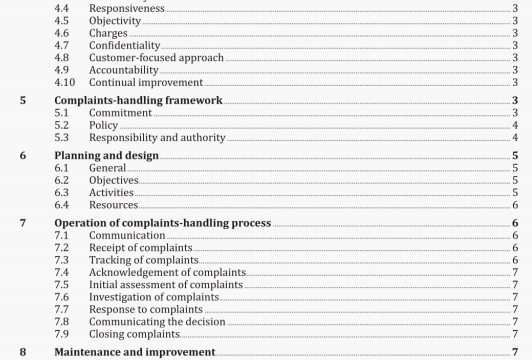ISO 10002 pdf download – Quality management- Customersatisfaction Guidelines for complaints handling in organizations.
7.4 Acknowledgement of conplaints
Receipt of each complaint should be acknowledged to the complainant Immediately (for example through
post, phone, or e.mall).
7.5 Initial assessment of complaints
After receipt, each complaint should be initially assessed in terms of criteria such as severity, safety implication, complexity, impact, and the need and possibility of immediate action.
7.6 Investigation of complaints
Every reasonable effort should be made to investigate all the relevant circumstances and information surroundmg a complaint. The level of Investigation should be commensurate with the seriousness. frequency of occurrence, and severity of the complaint.
7.7 Response to complaints
Following an appropriate investigation, the organization should offer a response (see Annex E), for example, correct the problem and prevent it happening in the future. If the complaint cannot be immediately resolved, then it should he dealt with in a manner intended to lead to Its effective resolution as soon as possible (see Annex F).
7.8 Communicating the decision
The decision or any action taken regarding the complaint, which is relevant to the complainant or to the personnel involved, should be communicated to them as soon as the decision or action is taken.
7.9 Closing complaints
If the complainant accepts the proposed decision or action, then the decision or action should be carried out and recorded.
If the complainant rejects the proposed decision or action, then the complaint should remain open, This should be recorded and the complamant should be Informed of alternative forms of Internal and external recourse available.
The organization should continue to monitor the progress of the complaint until all reasonable internal and external options of recourse are exhausted or the complainant is satisfied.
8 Maintenance and improvement
8.1 Collection of information
The organization should record the performance of its complaints-handling process. The organization should establish and implement procedures for recording complaints and responses and for using these records and managing them, while protecting any personal Information and ensuring the confidentiality of complainants.
This should include the following:
a) specifying steps for identifying, gathering, classifying, maintaining, storing, and disposing of records;
b) recording its handling of a complaint and maintaining these records, taking utmost care to preserve such items as electronic files and magnetic recording media, since records in these media can be lost as a result of mishandling or obsolescence:
a) Openness: well publicized, accessible, and understood by those involved in a complaint. The process should be clear and well publicized so that both personnel and complainants can follow them.
bJ Impartiality: avoiding any bias in dealing with the complainant, the person complained against, or the organization. The process should be designed to protect the person complained against from any biased treatment. Emphasis should be placed on solving the problem and not on assigning blame. If a complaint is made about personnel, the investigation should be carried out independently.
c) Confidentiality: the process should be designed to protect the complainant’s and customer’s identity, as far as is reasonably possible. This aspect is very important to avoid deterring possible complaints from people who might be afraid that giving details could lead to Inconvenience or discrimination.
d) Accessibility: the organization should allow the complarnant access to the ccirnplaints-handling process at any reasonable point or time. Information about the complaints process should be readily available in clear language and in formats accessible to all complainants. When a complaint affects different supply chain participants, a plan to coordinate a loint response should be made. The process should allow any information arising from the complaints to be known by any suppliers of the organization that are concerned by the complaint so that they are able to make improvements.
e) Completeness: finding out the relevant facts, talking to people from both sides involved in the wmplaint to establish a common ground and verify explanations, whenever possible.
f) Equitability: giving equal treatment to all people.
g) Sensitivity: each case should be considered an its merits, paying due care to individual differences and needs.
C.2 Objectivity for personnel
Complalnts’handling procedures should ensure that those complained against are treated objectively. This implies
— informing them immediately and completely on any complaint about their performance.
— giving them the opportunity to explain the circumstances and allowing them appropriate support.
ISO 10002 pdf download – Quality management- Customersatisfaction Guidelines for complaints handling in organizations
